B062—常思颖:象牙宫的终结? The end of the Ivory Palace?
对香港的象牙贸易和手工业进行采访。根据世界野生动物保护组织披露的数据,讲述香港作为亚洲象牙集散地的现状。对象牙消费和象牙走私提供了全新的解读角度。记者在香港采访多人,线索丰富。并且通过图表的方式,向中外读者更清晰的展示了现状。世界野生动物组织评价这一报道为象牙贸易新闻的重要报道。
By Sylvia Chang(HK Edition)

In view of the US-China agreement advocating a near-total ban on trading in ivory, a two-millennia-old industry in HK is on the verge of extinction. Sylvia Chang reports.
Over the last couple of months, ivory traders in the city have been meeting frequently, tocommiserate the imminent extinction of their craft and two-millennia-old industry. The loomingmisfortune is the result of an agreement by leaders of the world's two largest economies,virtually banning all trade in ivory and its products. The China-US agreement is the latest, andpossibly the ultimate, response to a global outcry over the wanton poaching of elephants, tosupply an illicit, underground trade.
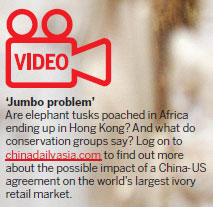
The men attending these gatherings are usually in theirsixties. They have spent their working lives in Hong Kong,trading in ivory. They started out as apprentices, graduated toivory carvers, learned the buying and selling of ivory, andmany went on to open their own businesses. Today, in theirtwilight years, they cannot believe the trade in which they haveearned their livelihoods is on the brink of extinction, like theelephants on whom their business depends.
"We're in the same boat with the elephants," laments ivorysculptor, Tung Pi-wang, who, at 58, reputedly is the youngestof Hong Kong's ivory carvers. "We love ivory like flies lovedecayed meat. That's how we live our lives." Most of hiscarvings are inspired by Chinese traditional drawings. He's won several international awards forhis work.
On Sept 25 a statement released by the White House Press Office declared, "The United Statesand China commit to enact nearly complete bans on ivory import and export, including significantand timely restrictions on the import of ivory as hunting trophies, and to take significant andtimely steps to halt the domestic commercial trade of ivory."
"We're going to die off before elephants are extinct," laments Daniel Chan Chun-bo, managingdirector of the Lise Carving & Jewellery Factory Limited in Hong Kong. He adds that only aboutseveral hundreds of practitioners remain in the ivory trade in the city. That's less than 1 percentof the number prior to 1989, the year that outrage over the wholesale slaughter of elephantsfinally boiled over and international efforts to ban the ivory trade intensified.
World's largest retailers
Hong Kong has more ivory items on sale than in any other city in the world, and is also a majortransit hub, conservationists say, citing a report this year by Save the Elephant, a UK-basedcharity. The report reveals that between 2014 and 2015, more than 30,000 items of ivory, withan aggregate weight of 1.5 tons, were on sale at 72 retail outlets in Hong Kong. Most of theitems were described as trinkets and small figurines.
"We believe that Hong Kong's ivory trade is fueling Africa's elephant poaching crisis," claimsGavin Edwards, director of conservation for the World Wide Fund for Nature - Hong Kong(WWF-HK).
On Oct 23, two conservation groups, WildAid and the African Wildlife Foundation, issued a jointcall for a total ban on ivory sales and at the same time demanded an independent inquiry intothe ivory trade here. Both sides blamed inadequacies in the SAR's regulation of the ivory trade.WWF-HK offered details of some of the regulatory lapses in a separate press release at the endof last month.
The releases came attached to photos of elephants, with their tusks hacked off by poachers. Allthree conservation groups blamed inadequate regulation by the HK government as well asambiguities in ivory trading.
Government documents reveal that the weight of smuggled ivory seized by Hong Kong Customsofficials between 2000 and 2013 totals more than 30 tons, equal to the weight of the ivoryextracted from about 1,800 elephants. Conservationists say this does not represent the truepicture, by far.
Statistics released under the Convention on International Trade in Endangered Species of Floraand Fauna (CITES) show that between 1989 and 2011, 70 percent of the ivory harvestedglobally found its way into China, much of it through smuggling.
Professor Zhang Li of the Institute of Ecology at Beijing Normal University says that demand forivory is not the only motivation for the poaching of African elephants. "The consumption of ivoryis a global issue, related to the regulations and to the corruption of the authorities in Africancountries as well," Zhang says.
Unchanged stockpile
In 1989, a ban on the international trade of ivory was implemented under CITES. However, theinternational agreement did not go so far as to ban Hong Kong's ivory traders from doingbusiness, only restricted sales to registered stockpiles of ivory from animals harvested before1990. Re-export from those stocks is prohibited under the CITES agreement.
Hong Kong government statistics show a 65 percent decline in the registered stock between1989 and 2004 - from 665 to 236 tons. Between 2008 and 2010, the government had stoppedkeeping track of ivory registered for non-commercial purposes. Since then, the combined weightof the registered stockpile has remained relatively unchanged, in spite of the apparent surge oftourists on shopping trips to the city.
Conservationists question how this can be so, noting that while reserves have remained stable,there is high demand for ivory, fueled by a nearly astronomical increase in the number ofmainland tourists, swarming the city in search of luxury items.
The stockpile, including raw material, is monitored by the Agriculture, Fisheries andConservation Department (AFCD). In a recent e-mail response to enquiries from China Daily, aspokesman of AFCD says, "There is no correlation between the quantity of registered ivorystock under License to Possess and the number of tourists visiting Hong Kong." But no furtherinsight was offered into the apparent anomaly that seems to suggest Hong Kong's ivory reserveis not being used.
Edwards of WWF-HK suspects that contraband ivory is "laundered" - shipped to Hong Kongamong certified, authorized shipments of ivory. Loopholes in the regulations make launderingquite possible, he explains. Each piece of raw ivory or ivory that was partially worked before1989 is certified with both a license and a serial number. The requirement for certification iswaived for "finished" works. That's one loophole open to smugglers.
Another means of laundering is by shipping mammoth tusks together with elephant tusks, saysEdwards. "Sometimes traders mix the two, and claim that they're trading only in mammoth ivory,which can be used as a front for continuing to sell illegal ivory."
Traders interviewed confirmed that the AFCD does not issue certification for finished worksproduced from the registered ivory stockpile. They also agreed that proper certification wouldmake it much harder to launder contraband ivory.
In its e-mailed response, the AFCD said the department only recently introduced a markingsystem using "tamper-proof holograms and photographic records for ivory". The departmentassures that the new tactic will allow it to run "a comprehensive stock check" of ivory covered byLicenses to Possess. No timeline was provided for the completion of the work.
Is no one buying?
Some traders argue that the lack of significant decline in the local stockpile of ivory is the endresult of a market collapse, i.e. there is no trading in ivory any more. Edwards rejects thatargument. "I can't imagine 80 plus shops with licenses to sell ivory at locations around the city,where the rent is very high, like Hollywood Road (in Central), Nathan Road (in Tsim Sha Tsui),etc. How is it possible to run a business and claim that you're selling nothing?"
Traders counter that they are selling next to nothing. "Two or three years ago the Chinesemarket could take up to 100 tons per year, but now it's less than 10 tons," Chan estimates. Heowns a manufacturing company on the mainland. The company's annual turnover "has declinedto less than 20 percent of the peak trade", he contends.
Traders including Chan say they deal mostly in ivory from mammoths, which have been extinctfor 10,000 years. Mammoth ivory is harvested in Russia and other countries close to the Arctic.
Chan says 90 percent of his trade is based on mammoth ivory which he has been buying since1983. "Right now I only carve elephant ivories from my inventory when clients order them," saysChan, who claims to own two raw elephant tusks, and about one thousand kilograms of carvedworks. That's less than 10 percent of what he says he had in stock during the 1990s.
"The legal market for ivory is shrinking due to the rampant illegal trade. The same is true of theChinese mainland," Zhang of Beijing Normal University notes. The State Forestry Administrationof the Chinese government restricted the consumption of raw ivory to 5 tons per year. Zhangexplains that demand last year fell short of the quota.
Ivories from pre-1975
Still, the market demand is hard to estimate. Hong Kong traders say that the existing stockpile issufficient. They claim they are working with ivory which was in circulation prior to 1975 when theCITES regulations came into effect. Among that pre-Convention ivory are antique ivory acquiredfrom auctions.
The import, re-export and trade in these ivories is permissible. According to AFCD, the quantityof pre-Convention ivory imported into Hong Kong in 2014 was about 4,152 kg, more than fourtimes the amount of 989 kg in 2013. In 2010, only 21 kg was imported.
Simon Pong Tat-lei, 65, managing director of Cheung Shing Art Company, says that most pre-Convention ivory imported into Hong Kong is raw material - whole tusks. He says traders usuallyre-export these ivories to cities on the Chinese mainland and have them processed there.
This sole, lawful means of conducting ivory trade across borders is now to be wiped off theboard. The China-US agreement, signed in September, suggests an almost complete ban onivory imports and exports.
Zhang of Beijing Normal University calls the agreement a "clear sign that concrete steps" will betaken on China's side to outlaw the country's ivory trade. He suggests that Hong Kong follow thelead and work toward a complete ban in the local market as well.
On Oct 15, in a speedy response to the bilateral agreement, China's State ForestryAdministration announced a one-year ban on the import of ivory, acquired from trophy huntingin Africa.
The import of pre-Convention ivory is scheduled to be banned latest by next year, according toa senior officer of the State Forestry Administration.
Pong reveals that in the latest check by the AFCD two weeks ago, the officials asked him toquote the prices of his ivories, and recorded them. "The AFCD never did that before. This mightbe a sign that Hong Kong government has plans to purchase back the ivory stockpile in the nearfuture," Pong says.
Contact the writer at mailto:sylvia@chinadailyhk.com
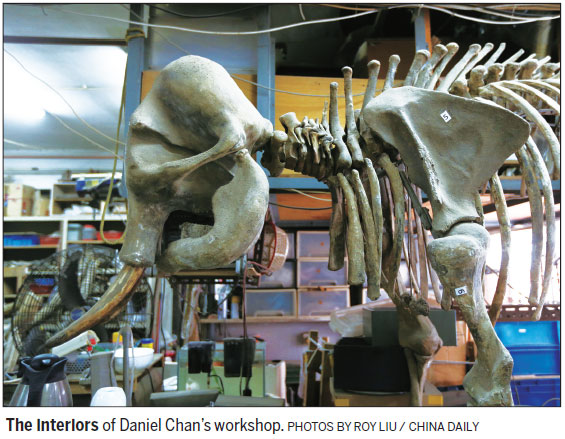
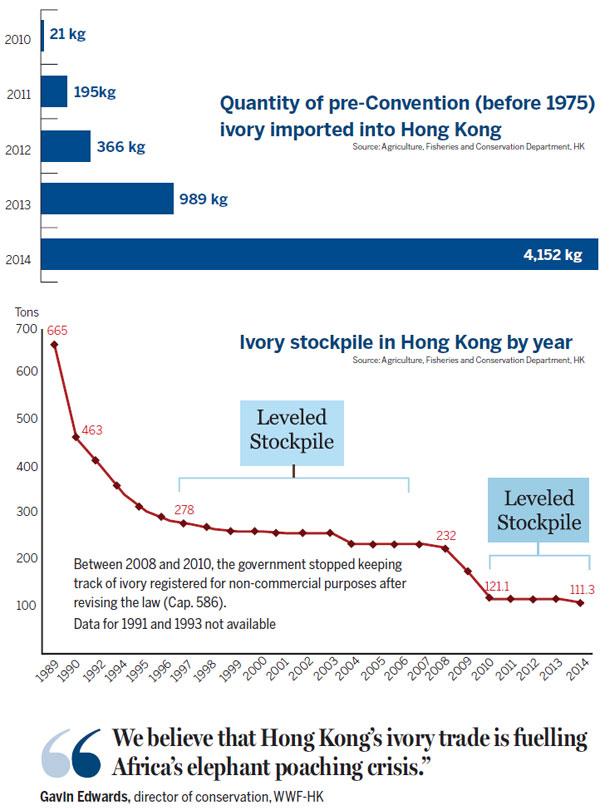
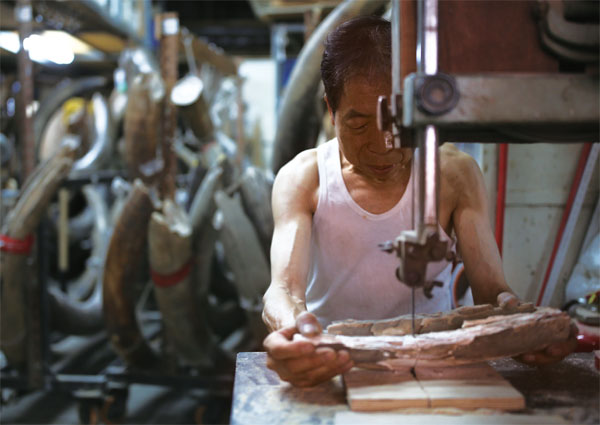 Only a few ivory sculptors have remained in Hong Kong's ivory trade. |

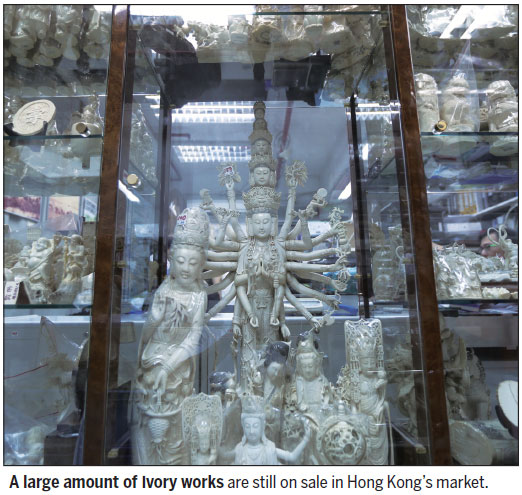
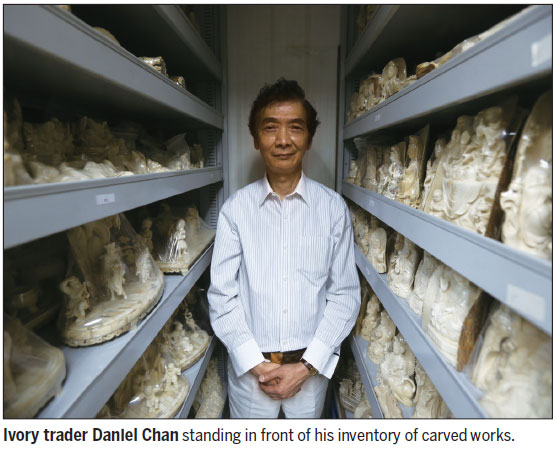
来源:http://www.chinadaily.com.cn/hkedition/2015-10/29/content_22304167.htm
- 浏览 1575 次

添加新评论